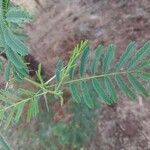Shrub or small tree 1–8(–12) m. high, sometimes suckering and thicket-forming or (fide Greenway) even scandent, with rough bark and armed with spines terminating short lateral spreading twigs which often bear leaves and flowers.. Young branchlets ± pubescent.. Leaves with (2–)5–19(–21 fide F.C.B.) pairs of pinnae; rhachis (with petiole) 0.5–20 cm. long, with one stalked gland between each pair of pinnae; leaflets 9–41 pairs, 1–11 (–14) mm. long, 0.3–4(–5.5) mm. wide, linear to oblong.. Inflorescences yellow in apical hermaphrodite part, mauve, pink or sometimes white in lower neuter part, 2–5 cm. long, pendent on solitary or apparently fascicled peduncles 1–9 cm. long.. Calyx 0.6–1.25 mm. long.. Corolla 1.5–3 mm. long.. Stamen-filaments of hermaphrodite flowers 3.25–3.5 mm. long; staminodes 4–17 mm. long.. Pods 2–10 cm. long, 0.5–2(–2–5 fide F.C.B.) cm. wide.. Seeds 4–6 mm. long, 3–4.5 mm. wide, deep brown, glossy.
Perennial shrub or small tree, (0.5-)5.0-6.0(-15.0) m high; with branches intertwined; dwarf spur branches (spines) are often leaf-bearing, not paired. Leaves bipinnate. Pinnae 4-19 pairs. Leaflets up to 41 pairs per pinna, narrowly obovate to lanceolate, dark green, rather glossy on upper, but dull on lower surface, rachis with little stalked glands; petioles without a gland. Inflorescences with flowers in a bicoloured, elongated, pendulous spike, half the spike formed by sterile pink staminodes and other half a short, compact, yellow catkin. Calyx campanulate, shortly 5-toothed or nearly truncate. Pod leathery, curly and twisted, densely clustered in bunches, indehiscent.
A shrub or small acacia like tree. It grows 5-6 m high in dry areas and 12 m high in wetter places. The stems are often twisted and twined together. The side branches form spines. It loses its leaves during the year. The leaves are compound. There are 4-13 pairs of stalks each with 27 pairs of leaflets. The leaflets are narrow and 10 mm long by 3 mm wide. They are dark green and glossy above but dull underneath. The flowers are in spikes in the axils of leaves. Half the flower spike is sterile flowers and the other half are fertile. The flower spikes hangs downwards. The fruit is a cluster of pods. Each one is 10 cm long by 1 cm wide. They are twisted.
Shrub or small tree 1-8(12) m. high, sometimes suckering and thicket-forming or (fide Greenway) even scandent, with rough bark and armed with spines terminating short lateral spreading twigs which often bear leaves and flowers; young branchlets usually ± pubescent, sometimes puberulous or even glabrous.
Leaves with (2)5-19(21 fide F.C.B.) pairs of pinnae; rhachis (with petiole) 0·5-20 cm. long, with one stalked or occasionally sessile gland between each pair, or at least the distal and basal pairs, of pinnae; leaflets 9-41 pairs, 1-11(14) x 0·3-4(5·5) mm., linear to oblong.
Inflorescences yellow in apical hermaphrodite part, mauve or pink or sometimes white in lower neuter part, 2-5 cm. long, pendent on solitary or apparently fascicled peduncles 1-9 cm. long.
A very variable and taxonomically complex species, widespread in Africa and Asia, reaching Australia.
Stamen-filaments of hermaphrodite flowers 3·25-3·5 mm. long; staminodes 4-17 mm. long.
Seeds 4-6 x 3-4·5 mm., deep-brown, glossy.
Calyx 0·6-1·25 mm. long.
Pods 2-10 x 0·5-2·6 cm.
Corolla 1·5-3 mm. long.








